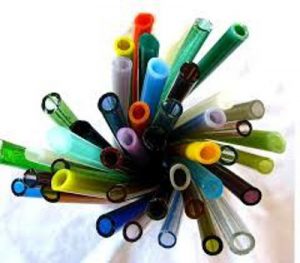COE
CONFUSION OR EFFECTIVE
What it means is coefficient of expansion. It is a measurement of the rate that glass will expand and contract when it is heated and cooled. In the good old days, we just lived and died by put 90 COE together or put 96 COE together. It did seem to work. It has become more complex. It is now a guideline not a "live by, die by rule". First now we hear about a lot more coes.Window glass (float glass) is somewhere between 84-87.

A bottle could be anywhere between 82-96.

Now we also deal with hot glass. The soft rods, glass and accessory are 104 COE
 The next confusion came when Bullseye announced they were Bullseye compatible and stopped saying 90 coe. I felt that Bullseye had to be aiming for something and that was 90; we had some comfort in saying you can put 90 with Bullseye.
We all loved System 96. We could put together Uroboros and Spectrum and that all worked fine. Then when those companies closed and Oceanside started manufacturing the Spectrum line, they followed what Bullseye did and said they were Oceanside compatible. So then, still feeling they were headed for some number for compatibility and that number was 96, we were still ok saying “sure put it with Wissmach and Youghiogheny 96”.
Youghiogheny even was testing their 96 to Oceanside and Wissmach.
Did we see some odd results coming out of the kiln? Yes, we did, now and then. When breakage happens, it is going to be thermal shock, bad annealing, or incompatibility. For this blog we are focusing on incompatibility.
Bullseye does a wonderful job of putting out technical data. They are clear about saying that coe is NOT the only measure of compatibility. Viscosity of glass is equally as important. Viscosity is resistance to flow.
The next confusion came when Bullseye announced they were Bullseye compatible and stopped saying 90 coe. I felt that Bullseye had to be aiming for something and that was 90; we had some comfort in saying you can put 90 with Bullseye.
We all loved System 96. We could put together Uroboros and Spectrum and that all worked fine. Then when those companies closed and Oceanside started manufacturing the Spectrum line, they followed what Bullseye did and said they were Oceanside compatible. So then, still feeling they were headed for some number for compatibility and that number was 96, we were still ok saying “sure put it with Wissmach and Youghiogheny 96”.
Youghiogheny even was testing their 96 to Oceanside and Wissmach.
Did we see some odd results coming out of the kiln? Yes, we did, now and then. When breakage happens, it is going to be thermal shock, bad annealing, or incompatibility. For this blog we are focusing on incompatibility.
Bullseye does a wonderful job of putting out technical data. They are clear about saying that coe is NOT the only measure of compatibility. Viscosity of glass is equally as important. Viscosity is resistance to flow.
This direction from Bullseye tech tips.
“Whereas expansion affects the compatibility
predominantly in the lower temperature range—below the
strain point—the viscosity properties affect compatibility
predominantly in the annealing range, from the annealing
point to the strain point. Differences in viscosity between
two glasses will cause compatibility problems. If one glass
is stiffer than the other, they will strain each other as they
cool through the annealing range.”
How can you know if your breakage occurred when annealing or fusing? If the break is sharp it broke during cooling (annealing). If the break is smooth over it, then it was still fusing after the break. So, what to do? If you are going to mix manufacturers, you need to test. They may be compatible. They may not.

